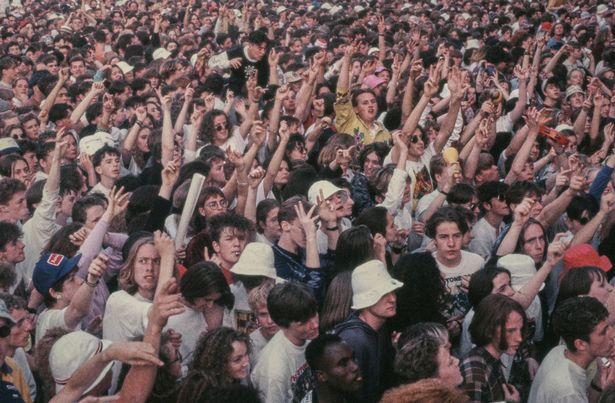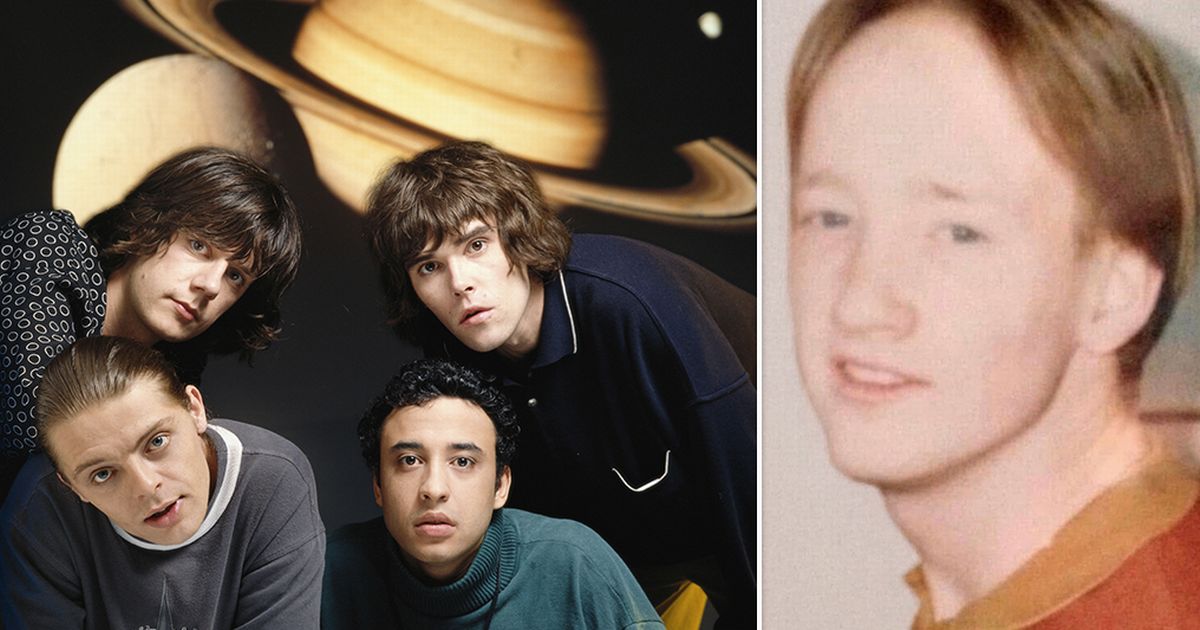‘Those fortunate enough to have lived through it are eternally grateful to Mani and that heady era of Manchester music’ The Stone Roses, left, and Simon Donohue(Image: Getty/Simon Donohue)
The Stone Roses, left, and Simon Donohue(Image: Getty/Simon Donohue)
The sad death of Stone Roses bassist Gary ‘Mani’ Mounfield has left middle-aged fans misty-eyed about a defining era of Manchester music. Born at exactly the right time, and in the right place, Simon Donohue was lucky enough to have lived through it. He believes there can never be another youth movement like it…
The first time I saw The Stone Roses was at the International 1 on Anson Road in Rusholme, today a fairly unremarkable supermarket next to a busy Manchester crossroads.
Little did I know it would be a landmark moment in a defining era of my young life. By some joyous twist of fate, I would go on to turn 18 in 1989 – the best possible year to come of age in Manchester.
Turned on to music by my older sister, I was already convinced that the only bands worth listening to came from Manchester. That was way before ‘baggy’ and even ‘indie’, with the music we listened to more likely to be described as ‘alternative’.
Dressed in turned-up Levi’s 501 jeans, a check shirt, and with a flat-top haircut, The Smiths had been the soundtrack to the teenage angst of my Salford school years. I was 15 when I first saw The Chameleons – arguably the biggest Manchester band never to make it massive – at Middleton Civic Theatre.
 Gary ‘Mani’ Mounfield(Image: Ryan Phillips/PA Wire)
Gary ‘Mani’ Mounfield(Image: Ryan Phillips/PA Wire)
I’d spent my 16th birthday in a near empty Hacienda in 1987, but only because the bouncers had turned me away from the much more fashionable Deville’s, where they’d play Iggy Pop, The Cult and The Cure.
That year, The Smiths split and a new sound was emerging. In particular, a lyrical love letter to Sally Cinnamon caught the ears of gig goers, curious about this new Manchester band called The Stone Roses.
That International 1 gig sits monochrome in my mind. I remember a friend wearing flares and a paisley shirt, a place packed with bodies, and that the performance itself was fairly shambolic. Sally Cinnamon was the clear crescendo.
At one point, lead singer Ian Brown asked if anyone could play bass guitar as they were seeking a replacement. That would be Gary ‘Mani’ Mounfield, who joined the band later that year.
It was an incredible privilege to be part of what would happen next. Those monochrome memories became vivid, bright and colourful as Manchester music momentarily caught the imagination of the world.
 Aerial view of The Stone Roses’ gig at Spike Island in Cheshire in 1990(Image: Halton Borough Council)
Aerial view of The Stone Roses’ gig at Spike Island in Cheshire in 1990(Image: Halton Borough Council)
My 501s made way for baggy Joe Bloggs jeans and people loosened up, wearing long sleeved white t-shirts and beanie hats. My flat-top hairstyle became a set of floppy fringed curtains that have long since parted.
It was edgy, exciting, exhilarating. But perhaps the best way to capture the frenetic pace of all that creativity is to present a few dates in a packed calendar over only 18 months or so.
It’s Monday November 21, 1988, and the Happy Mondays release Bummed. It’s their seminal second studio album, and still the most vivid expression of what might happen when kids with guitars and keyboards are exposed to drugs and dance music.
But get this. Two members of the Mondays – Gaz Whelan and Mark Day – had attended my own school. The rest were also famous in the pubs and clubs of Walkden and Swinton and would soon be known across the world.
It’s Monday January 30, 1989, and New Order unleash Technique, an album demonstrating what happens when Mancunian former punks meet Balearic inspirations.
 Simon Donohue(Image: Simon Donohue)
Simon Donohue(Image: Simon Donohue)
It’s Saturday March 4, 1989, and I’m watching James, supported by the Inspiral Carpets, at the Free Trade Hall. Now the Radisson Edwardian Manchester hotel, it had previously hosted landmark gigs by the Sex Pistols and Bob Dylan, who plugged in his electric guitar and was accused of being ‘Judas’ by fans of his former folk sound. This time local history was being made.
It’s Tuesday May 2,1989, and I’m at home in Walkden, peeling cellophane from the cover of The Stone Roses’ eponymous debut LP. I lower the stylus into the groove of side one, only to hear Mani’s rumbling bassline introduction to I Wanna be Adored. After months of anticipation, this sixties-inspired psychedelic masterpiece is living up to my wildest dreams.
Further into 1989, I’m at a ‘school night’ gig at the Hacienda watching the Happy Mondays. Every Tuesday night, I’m tuned into the 808 State show on Sunset Radio, revelling in the dark delights of acid house. Pretty much every week we’re at The Boardwalk, the Hacienda, or Konspiracy: an indie kid turning tentative moves in some sweatbox rave club. On occasions, I drive my battered yellow Mini to warehouse parties on industrial estates in East Lancashire.
 The crowd at The Stone Roses at Spike Island(Image: Glyn Howells, Getty Images)
The crowd at The Stone Roses at Spike Island(Image: Glyn Howells, Getty Images)
Fast forward into 1990, and I see The Charlatans in an upstairs room of the Crown and Cushion pub in Bolton, the landlord having secured the booking weeks before they’d troubled the indie charts with Indian Rope.
We see Northside, The Mock Turtles, The High, MC Buzz B, the New Fast Automatic Daffodils, World Of Twist, Paris Angels, 808 State, and my friends’ band, The Crystal Set, one of many that didn’t quite make it massive.
Then, it’s a windy Saturday in May 1990 and The Stone Roses are playing Spike Island in Widnes, Cheshire – high watermark in many ways of the Madchester era. I’m there with a group of friends, all having the time of our lives.
It sets the scene for The Verve, Elbow, Oasis, The Courteeners, Blossoms, and so much more.
The lazily re-written legend of modern Manchester suggests that era was only thanks to Factory Records, the Hacienda, Tony Wilson, ecstasy. They were all part of it for many people, that’s clear, but as Ian Brown sang so sweetly in Sally Cinnamon, ‘it needed so much more’.
People who’d looked down at me for wearing a Smiths t-shirt at school were turning up at the same nightclubs as me: fans of guitar music partying alongside school bullies to indie/dance crossover music.
 The Stone Roses(Image: Photo by Mike Prior/Getty Images)
The Stone Roses(Image: Photo by Mike Prior/Getty Images)
The ‘Madchester’ label still makes me cringe and those of us who lived through it simply felt part of a vibrant, organic movement – one that united fans and musicians from diverse backgrounds.
As a journalist and music writer, I went on to meet and interview many of those heroes, so feel like it inspired me in other ways too.
Sadly, I’m convinced it’s the last youth movement of its kind. Spotify means musical tastes are far more eclectic with unlimited influences and no borders defined by location. That’s no bad thing.
Back then, the recommendations came from people who drank in the same bars, danced in the same clubs, went to see the same shows, or read Kevin Bourke’s Briefing and The Word in the Manchester Evening News. Somehow word spilled out into the rest of the world.
There’s loads of amazing music that’s still being made in Manchester, but I’d argue that there will never again be a similar rising of youth culture defined purely by geography. Not in Manchester, Liverpool, Seattle, or anywhere else.
But those fortunate enough to have lived through it are eternally grateful to Mani, and that heady era of Manchester music.
